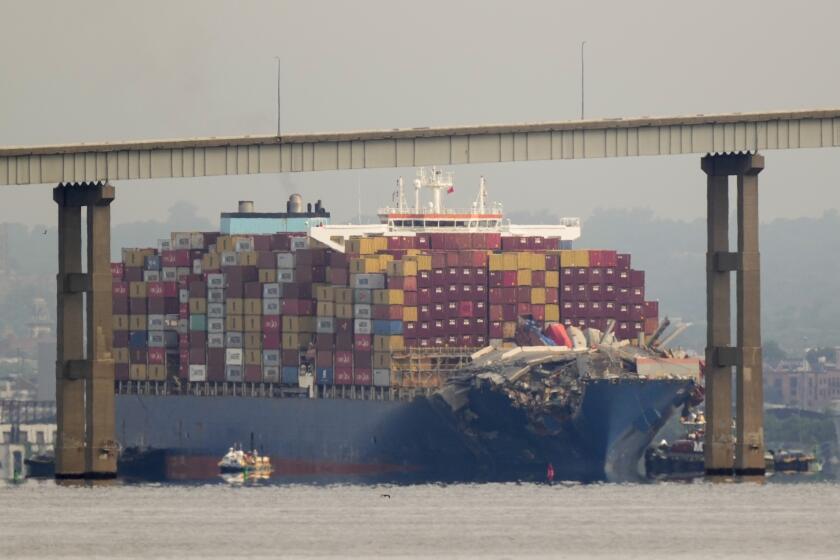Florida Residents Dig Out from Hurricane’s Wake
In complete disbelief, Rhonda Griffin watched as foaming salt water from the Gulf of Mexico spilled into the parking lot of the seafood restaurant that she and her husband own three miles from the open water.
The 41-year-old woman, a sixth-generation resident of this hamlet in the Florida Panhandle named for the supposedly curative powers of a nearby mineral spring, got on the cellphone to her mother.
“I said, ‘Momma, you’re not going to believe this,’ ” Griffin said. Worse was soon to come: in 15 minutes, Griffin said, her restaurant’s dining room was under a foot of seawater.
“I prayed to God, ‘Let it be it.’ Well, it wasn’t it,” Griffin said.
On Monday, like many residents of what is known locally as Florida’s “Forgotten Coast,” she and her husband Chris were laboring to recover from the freakish weekend trick played on them by Hurricane Dennis.
The first hurricane of the 2005 Atlantic storm season may have been less of a menace than meteorologists had originally feared, but as it cruised for a landfall at Florida’s far western edge, Dennis stirred up huge waves in the Gulf of Mexico. Those waves surged onto the sparsely populated, pine-forested shoreline south of Tallahassee, more than 160 miles east of where the storm touched land.
“Dennis was 145 mph [of sustained winds] when it went by us, and it whipped up a big wake the way a boat would,” said Joe Blanchard, director of emergency management for Wakulla County. Instead of the predicted 6-foot rise in the level of the Gulf of Mexico, the waters rose 12 feet. “We haven’t had this much storm surge since 1927,” he said.
More than 100 homes along the Forgotten Coast (or, as some here prefer, Silver Coast) were flooded, as were half of the restaurants in Wakulla County, most of which are located on or near the water, Blanchard said.
In parts of St. Marks, the water for a time was chest-deep. Griffin said she and her husband needed a boat to rescue a woman she knows only as Miss Bernice, who bakes the pies served to customers at their restaurant, the Landing. The 83-year-old woman was trapped by floodwaters in her Panacea home.
“We like to say that God likes this place as much as we do, so much that he protects it,” Griffin said. “Maybe he didn’t like us so much yesterday.”
On Monday afternoon, she and her husband were using a carpet water extractor, a sort of vacuum cleaner made to suck water from floor covering, to try to get the purple wall-to-wall carpeting at the Landing dry enough to reopen. It was a warm, sunny day typical for July in Florida, and the smell of mildew was apparent. Metal legs on chairs in the dining room already had begun to rust, Griffin said.
“You deal with the immediate damage, and hold your breath for what’s coming,” she said.
Dennis left more than 500,000 customers in Florida, Alabama and Mississippi without power, and was blamed for at least five fatalities.
In Florida, a Fort Lauderdale man was electrocuted when he stepped on a downed power line. In Nassau County, a 13-year-old boy drowned while swimming. In Walton County, a 3-year-old was killed when his parents drove into him while evacuating their home. A 55-year-old man in Escambia County died of carbon monoxide poisoning from a generator in his garage.
And in Decatur, Ga., a 35-year-old man was killed when a tree toppled over onto his bedroom as he slept.
Insurance experts estimated the damage to insured property from the hurricane at $1 billion to $5 billion. Michael D. Brown, director of the Federal Emergency Management Agency, said that although the damage hadn’t been as severe as expected, Dennis had been devastating to people whose homes were damaged.
The Florida Division of Emergency Management reported that more than 30 centers were distributing food, water and ice to hurricane victims in Escambia, Walton and Santa Rosa counties. Relief crews fanned out over northwest Florida to assess the damage.
By Monday morning, Dennis, which had been a Category 3 hurricane at landfall with 120 mph sustained winds, had weakened to a tropical depression. The National Hurricane Center said the storm brought thunderstorms and 3 to 6 inches of rain to Tennessee, Kentucky, Illinois and Indiana as it moved into the Ohio River Valley.
The coastline of Wakulla County, where many of the 27,000 inhabitants used to make a living fishing for mullet until Florida outlawed the nets they used, was not the only segment of the gulf shoreline that felt the storm’s fury. On Navarre Beach, a pier was cut in two. In Pensacola, Fla., floodwaters from the gulf covered downtown sidewalks.
On Florida’s Santa Rosa Island, where Dennis came ashore, power, water and sewer lines were destroyed and roadways were blocked. “There are roofs all over the place,” said Sgt. Scott Haines of the Santa Rosa County Sheriff’s Office. “Most buildings have had serious damage.”
Only one resident holed up in his beach apartment as Dennis arrived, Haines said, and emergency officials verified Monday that he was still alive.
Blanchard said Wakulla County, two-thirds of which is covered by the Apalachicola National Forest and a national wildlife refuge, is especially vulnerable to storm surge because the gulf shelf is as shallow as 20 feet deep 20 miles offshore. Water driven toward land piles up there and sends large waves ashore, he said. Building codes require properties near the water to be on pilings, Blanchard said, but those regulations don’t apply to older structures.
On Sunday, the Johnsons, who live on Surf Avenue in Panacea, a town of 2,100, found surf inside their house.
“We had 4-foot breakers coming through our living room,” said Noel Johnson, 43, a construction superintendent. The waves battered down sliding glass doors facing the bay and destroyed their furniture and appliances. Johnson, his 45-year-old wife and their two grandchildren fled in his truck.*
Times researcher Jenny Jarvie in Atlanta contributed to this report.
*
(BEGIN TEXT OF INFOBOX)
A matter of timing
Maximum sustained winds in Hurricane Dennis dropped from 145 mph to about 120 mph in the final hours before Sunday’s landfall. Colder water near shore may have sapped some power. Another factor, weather experts say, is that the hurricane was at a relatively weak stage in an eye wall regeneration cycle.
In the eye of Dennis
The center, or eye, of a hurricane is relatively calm with sinking air, light winds and few clouds. The most violent winds and rain take place in theeye wall, the ring of thunderstorms immediately
surrounding the eye.
*
Eye wall generations
In powerful hurricanes such as Dennis, outer bands of storms encircle the primary eye wall, thus forming a second eye wall.
--
Sources: National Oceanic and Atmospheric Administration; NASA; Associated Press
More to Read
Start your day right
Sign up for Essential California for news, features and recommendations from the L.A. Times and beyond in your inbox six days a week.
You may occasionally receive promotional content from the Los Angeles Times.






